#SH R E K
Text
Send Smash or Pass + a name and my muse will say if they would smash or pass on that person.
@madrites asked: smash or pass shrek


"I'd hate to harm my dearest ogre .... it also seems impossible to smash him ... he is big a strong and manly ..... so.... pass!"

6 notes
·
View notes
Text

unmentionable a h e ms are aligned right behind this shelf btw
#so much bl manga………….. all with rather suggestive covers…………#ngl i would’ve looked at them if my mother weren’t there too. like y’all i picked up a sasa-miya dvd and she went ‘wHY NOT BUY IT’#imagine what she’d do if i browsed the bl………..#anywayssss it’s kinda funny how mona’s right there with all of those villainess isekai manga…..#i’ve been kinda hooked on that genre as of late tbh and i was wondering w h y y y yy and then i remembered asuna exists lol#thank you asuna for getting me into another genre of comics and stuff ilyyyyyyy#on another note. mannn. i didn’t expect o sh i n o k o to be literally everywhere…… like b kom a c hi are even on vending machines…………#the a ri m a. kan a vending machine water was tempting ngl…. but alas i had no coins#idol was also played like everywhere too it was….. unexpected tbh.#but on another another note… public transportation fares are pretty high here? to think that i used to complain about ~$2.10 commutes….#o h w el ls either way i need to find a way to open idol sengen to check minami’s manager’s name without my family noticing o r s o help m e#inedible blubbering
17 notes
·
View notes
Text
youtube
#koushirouizumi ref#koushirouizumi fl#koushirouizumi fl ref#koushirouizumi fam#(M e ' Hey I need a simple and effective way to describe what a high Cat4~5 sounds like to people who ') :') :') :') ...#(Me ' probs wouldnt give a single genuine actual sh*t about *any of this* either way but ')#(Me ' ... ')#(Me ' Holy sh*t it sounds {almost} exactly like I remember it ')#(I actually hadnt watched Andrew stuff in a LONG TIME because negl it was a little . traumatizing to hear this again)#(There's damage seen towards the end as a warning)#(We also Know PeopleTM QUITE Close to that T u r k e y P o i n t area and)#(sh*T I knew it had bad damage to it but tHAT BAD W O W)#(I mean I expected it too but...)#(Protip: if they tell you + fam to evacuate gET THE HELL OUT OF THERE)#(around 2:10 timemark is some flashing which is a trans{former??} light blowing out)#(around 3:70 mark is the N.H.C radar literally BLOWING OUT and there is flashing too and it lasts for a while long)#(I had seen some of this footage before specifically the radar blowing footage and similar of the winds but NOT all of this)#(It's honestly so sh*t that other day was SO taken up by That GuyTM we could barely even get the date of This acknowledged)#(I wasn't finding ANYTHING the other day other than 'oh here's our passing mention of Andrew in our current forecast!!1!')#(Anyway I have license to link to this AND talk about it)#(considering MY WHOLE DAMN FL FAM LIVED through this storm and multiple Cat 4s that passed through after)#(even if we WERENT immediately in the eye)#(LIKE??? MY CHILDHOOD HOME WAS STILL HEAVILY DAMAGED BY ANDREW???? EVEN IF IT ~~WASNT FLATTENED~~????)#(It was *like half the house* on various ends but BECAUSE WE {FAM} EVACUATED we DIDNT HAVE TO WITHSTAND THAT but)#(*NOT EVERYONE COULD GET OUT*)#(Almost everyone we know 30+ in FL has memories if not other fam that remembers living through specifically THIS STORM)#(And my fam was '''~INLAND~''' and even then many of us are tbh still shocked the whole fam end MADE IT THROUGH this storm)#(Like its COMMON for us to talk abt it BECAUSE WE ALMOST ALL WENT THROUGH IT except the youngest of F.L. fam end!!)#(It was literally LIKE HALF OF J E W I S H end {+a fam friend!} crammed into one fam place for THE WHOLE NIGHT+ into the next days)#(Like I honestly dont even *know* anymore how to describe how terrifying these storms can get unless I LINK SOMETHING like this)
0 notes
Text
dynamics ; pluto 1/2
#x. r. peters + l. patterson [ pluto ; sh ]#x. e. munson + s. harrington [ pluto ; sh ]#x. k. harley + j.collier [ pluto ; sh ]#x. f. minkus + m. kent [ pluto ; sh ]#x. l. friar + f. minkus [ pluto ; sh ]#x. e. blight + hunter [ pluto ; sh ]#x. r. peters + v. lopez [ pluto ; sh ]#x. m. dickens + s. daniels [ pluto ; sh ]#x. n. wheeler + r. buckley [ pluto ; sh ]#x. j. molina + c. wilson [ pluto ; sh ]#x. f. minkus + m. hart [ pluto ; sh ]
0 notes
Text
plaquinhas do Itzy feito por poonnye. Não modifique os símbolos e nem retire-os ou troque os cr do criador.
Itzy plaques made by poonnye. Do not modify the symbols or remove them or change the creator's cr.
placas Itzy hechas por poonnye. No modifiques los símbolos ni los elimines ni cambies el cr del creador.ㅤ
ㅤ ︵⏜᷼ ✿ ׄ ݂ ᩡ 👠 ׄ ׅ ◶ ໋ ◍ ⪨
ꣀ ۟ ׅ ﹪ 𝐇࣭ɯֹ︩︪⍺ոg 𝐘ᥱʝꪱ ✻ ׄ ׅ ꮺ
⎯⎯︎︎︎︎ 𝐁oy dr⍺nk ⍺ll th⍺t m⍺gnoli⍺ winᧉ
﹋ ֹ ࣭ 𝐎n hᧉr bl⍺ck s⍺tin shᧉᧉts' ֹ ࣭ ⩉
໑ ִ ֹ ɯhᧉrᧉ hᧉ st⍺rt⵿ᧉd tⱺ frᧉ⍺k ֹ ࣭ ꒱
┈┈┈ ֺ ࣭ 𝐏ᦞᦞ𝗻𝗻ყᧉ ࣭ ֺ ┈┈┈
︶⏝ ֹ ࣭ ⊹ ❒ ♡ ִ ֹ ⏝︶
❑ ֺ ࣭ ↺ ❀̸ ⍺ç⍺̃o.
ㅤㅤ───── fαlα.
ㅤㅤㅤㅤ
⩉ ֹ ִ ✿̸ ࣭🌺⃟ ֹ ִ ﹪ 𝕳
𒀭 ֹ ࣭ ᶩᵒᵓᵒ 𝐒ჩ࣭Ꭵո 𝐑ყꭎjᎥո ࣭ ֹ ꮺ
ֹ ࣭ 𝐘ⱺu gⱺt mᧉ ᥣikᧉ cr⍺zყ iո lⱺvᧉ ׄ ׅ ✻
╾──ׄ ׄ ׅ ᶜʳ ᵖᵒׄᵒⁿⁿ꤫ʸׄᵉ ✿ ꒷꒷꒦⏝︶
◕ ׄ 🌺 ׅ⎯⎯̸ ação
꯳ ׄ 🌺 ࣭ ⩉ fala
𖦹 ׄ ᩡ ׄ ✿ ⱺbserv⍺ções:
𖦹 ׄ ᩡ ׄ ✿ cⱺuple:
⩉ ﹋ ◕ ࣭ ☀️̸ ׄ ✻ ࣭ ꯳̸
⎯⎯ ֹ ׅ 𝐂ჩⱺᎥ 𝐋Ꭵᥲ̸ ᵚᵅᵑᵑᵅᵇᵉ ֹ ׅ 𖦹
꒷꒥꒦꒷ ֹ ᶜʳ ᵖᵒׄᵒⁿ͝ⁿ꤫ʸׄᵉ ׅ ໋ ⪨
͝ ⏝︶ ﹪ ֹ 𝐈𝐓𝐙𝐘 ׅ ✿
❍ ֹ ׅ ação
└─── fala
﹪ ֹ ☀️✻ ⱺbserv⍺ções:
﹪ ֹ ☀️ ✻ cⱺuple:
#aestheitcs#symbols#kpop rp#kpop aesthetic#dark#enfeites#messy#soft#nicknames#nicknamecheio#original rpg#city rpg#new rpg#plaquinhas#forum rpg#rpg ressources#faceclaim rpg#símbolos#cute simbols#paquerette#messy bios#kpop messy#itzy chaeryeong#itzy yeji#jyp itzy
2K notes
·
View notes
Text
Just plain babbling about shorthand
Since reading Dracula might be the first time or one of the first times that people have heard about shorthand, I thought I'd take this thin excuse to infodump. Because I find it fascinating and want to share. (Warning ahead of time, watch out for how many darn times I say "for example" in this post).
For some background, shorthand systems of writing have existed for millennia, but in the English-speaking world, the two most common and well-established systems of shorthand are Pitman and Gregg. Odds are that the Harkers are writing in Pitman. It's the older system (created in 1837) and is to this day more common in England and the Commonwealth. Gregg is more common in America and was introduced in 1888, either only a few years after or a few years before Dracula takes place. There were also numerous other less popular systems floating around at the time.
Pitman and Gregg and most other shorthand systems are phonetic. (Teeline is a more modern shorthand system based on a simplified alphabet, which is also quite popular). Simply put, each sound is reduced to one stroke of the pen. In Gregg, for example, the sound "k" (which includes the letter "c) is a medium-sized forward arch, "a" is a large circle, and "ch" is a short, downward diagonal line. So, instead of writing "catch" you just combine the symbols for "k-a-ch." Instead of "become" you just write "b-k-m." (These "words" are known as outlines).
Some shapes represent multiple sounds. For example, a small circle stands for the vowels in "bit," "bet," and "beet." A large circle stands for the vowels in "cap" and "cape." This might sound like it would be confusing rather than simplifying, but it's generally clear from the context.
There are a bunch of other means which allow you to write more quickly. Common words are further shorted into "brief forms." For example, "the" is represented by "th," "after" by "a-f," and "were" by "e-r." Some common endings or beginnings are also abbreviated, so that "sh" at the end of a word can stand in for "-tion" and "f" can mean "for-" or "fore-" at the beginning of a word. Thus, "Permission" is "p-r-m-sh" and "forgive" is "f-g-v." Common phrases can be combined into a single outlines. For example, for "to be" you can write "t-b" instead of "t-u[space]b." "I have not been able" can be "a-v-n-b-a." (The large circle "a" is the brief form for the word "I" in one of the rare quirks of Gregg that isn't basically intuitive).
Pitman Shorthand is very similar to Gregg (or, more accurately, Gregg is similar to Pitman). Other than using different symbols (for example, in Pitman "k" is a short forward line) Pitman differs from Gregg mostly by its use of the thickness of strokes to differentiate sounds. For example, "g" is also a short forward line, with the only difference being that the line for "g" is drawn thicker than "k."
I learned shorthand absolutely because of Dracula, though for convenience I learned Gregg. As of right now, I'm pretty out-of-practice, and honestly I was never particularly fast. (At my best, I probably was on average as fast writing shorthand as cursive longhand; I think faster than printing, though).
If you're at all interested, I really recommend learning some form of shorthand. It's useful in note-taking or when you don't want people to be able to read your writing (if, you know, you're kidnapped by a vampire or trying to write fanfic at work). It's also just a fun hobby and a nifty skill to be able to say you have.
In my opinion, if you want to learn shorthand, Gregg Simplified is a solid option, because the materials are accessible and the system is a good middle-ground between easiness to learn and quickness to write. I taught myself just following along with the Gregg Shorthand Manual Simplified. The book is broken up into 67 short "lessons." I did one or two lessons a week, maybe a few hours of work, and I was "fluent" in less than a year. I also bought a Gregg Simplified Dictionary, but all you need is the Manual.
(Note that the manual is written both assuming you're probably some kind a secretary and in the fifties. So, you'll learn brief forms for super-useful phrases like "dear sir" or "remit." For practice, they have you read and copy these sample letters in shorthand, and it's almost hilarious how almost all the letters to men are about business matters and the letters to women are advertising sales. There is one spectacular letter that's a man writing to a newspaper to cancel his subscription, because he's moved into a house in the suburbs with another man who gets the same paper. I'm legit tempted to go through the manual again just to find that letter.)
Fun fact! The fastest shorthand stenographer ever recorded wrote faster than the fastest typist.
Also fun fact! It's not uncommon for individual people to invent their own brief forms based on words that they use commonly. So, Jonathan might have been writing "c-a-r-p" (or the Pitman equivalent) for "Carpathian" or Mina writing "t-b" for "Whitby" or both of them writing "v-a-m" for vampire. And I'll bet credits to navy beans they had specific brief forms for their favorite trains.
#dracula#dracula daily#shorthand#gregg shorthand#pitman shorthand#the gregg book also is certain that you pronounce the “h” in “wh” words#maybe you still do#but probably you don't#*marge simpson potato meme but with me and shorthand*
222 notes
·
View notes
Text
kragehund english spelling reform standard:
upper case discarded except for Humor, Vibes, and EMPHASIS
c now only used for ch sounds, k and s replase hard and soft c
x now used for sh sounds, ks will serve as replasement
ð and þ brought bak
ng replased wiþ ŋ
no addiŋ e to "r" sound unless nesessary
no mor extra e at all
no doubl letrs eiðr
q -> kw
no mor end of word y
g onli maks hard g sound, soft g replasd wiþ j
diskard al of ðos stupid gh, wr, ps, sorts of letr kombos
no silent letrs
vowls wil be lokalaisd to indievidual aksent and riten basd on personal preferins
hel, yu kan canj konsinints tu if yu want
sie? iznt ðis so muc iesier tu rid? wie xoud al rait laik ðis. aiv fiksd inglix.
104 notes
·
View notes
Text
THE NEW FUCKING EPISODE OF HELLUVA BOSS IM.sO NORMAL.
THE LAST SCENE BRO THE LAST SENE HIT DIFF
SPOLIERS AHEAD YOU HAVE BEEN WARNED
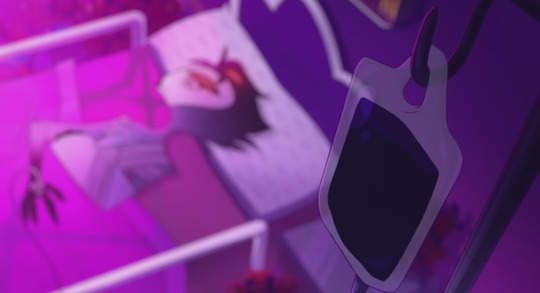

LOOK AT HIM LOOK HOW SAD AND LONELY AND EMPTY HE IS
HE IS RELIVING WHAT HAPPEND TO HIM AT STRIKERS LAIR YOU BITCH WHAT DID YOU DO TO MY BOY
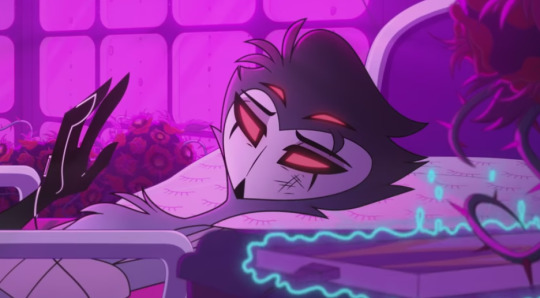
LOOK AT HIM WHEN HE LIFTS UP THE PHONE LOOK HOW EMPTY HE IS HE ISNT EVEN SHOCKED THAT SOMEONE SENT HIM SOMETHING HE MUST HAVE A LOT OF PEOPLE AND FANS SENDING STUFF TO HIM BUT HE DOESNT C A R E BECAUSE THAT FAN DOESNT ACTUALLY CARE ABOUT HIM AND IS CLOSE TO HIM BUT HE SEES THEM ANYWAYS BC ITS HIS ONLY FORM OF COMMUNICATION OF THE OUTSIDE WORLD

I JUST NEED TO POINT OUT AGAIN HOW SAD AND LONELY HE IS HE IS STILL FRESH OUT OF FUCKING TORTURE AND TRAMATIZED ANDANDNAJSAJShu
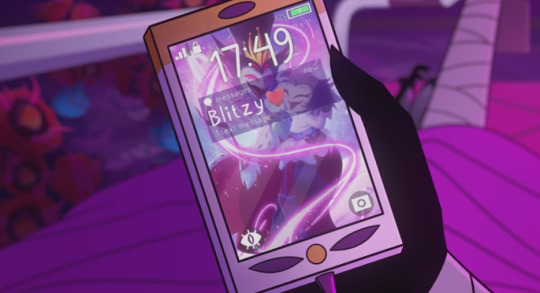
HE HAS HIS DAUGHTER AS HIS WALLPAPER OH MY GOD HE IS TRYING SO HARD TO BE A GOOD DAD TO HER I CANT-



LOOK AT THE MESSAGES WITH BLITZ FOR A SECOND AND REALIZE HOW IT DIDNT START AT THE BOTTOM OF THE CHAT IT STARTED OUT ON THE TOP OF IT THAT MEANS STOLAS HAS BEEN READING THE MESSAGES WITH BLITZO BECAUSE THATS HOW MUCH HE MISSES HIM AND HE WANTS HIM TO BE BY HIS SIDE AND HE JUST GENUINELY LOVE HIM SO MUCH IT HURTS
AND YOU SEE THE MESSAGES?? THIS ALSO HINTS AT HE IS TRYING TO CONVINCE BLITZO THAT HE DOESNT JUST CARE ABOUT SEX HE ALSO LOVES HIM AND C A R E S A BOUT SINCE THE OZZIES

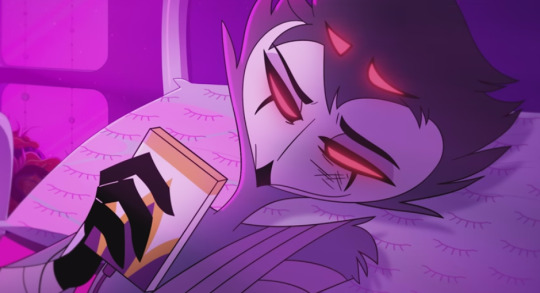
LOOK HOW HAPPY HE IS WHEN HE GETS THE MESSAGE FROM BLITZ ONE SINGLE MESSAGE FROM HIM MAKES HIM SMILE AND HE LOOKS SO HAPPY
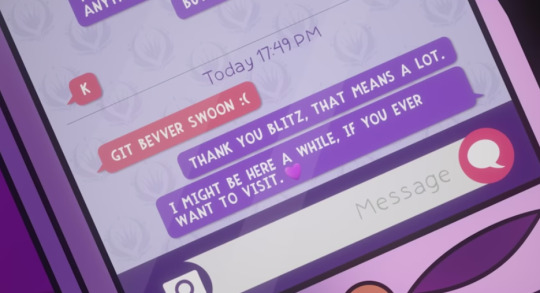
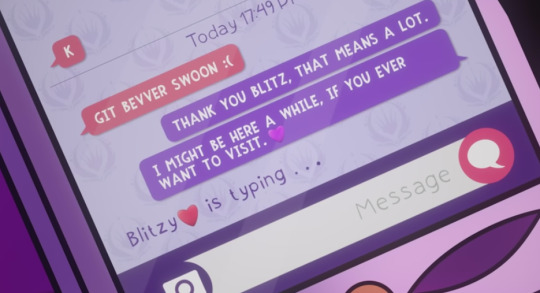






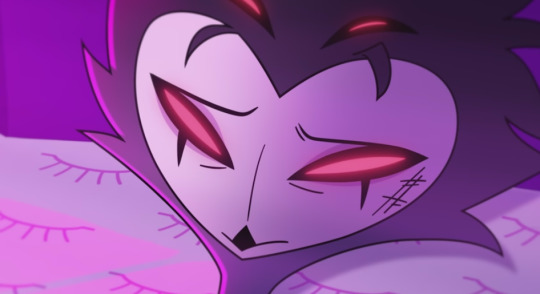
GUYS LOOKAHOW FAST HIS MOOD CHANGES WHEN HE REALIZES BLITZ IS NOT GONNA RESPOND HE LOOKS SO HOPELESS AND EMPTY HE JUST WANTS BLITZ TO BE WITH HIM AT HIS LOWEST AND WEAKEST BUT WHEN HE REALIZES HE CANT HAVE THAT HE LOSES ALL HOPE


AND INSTEAD OF PUTTING THE PHONE BACK W/ HIS POWERS LIKE HE DID BEFORE HE USES HIS HANDS BECAUSE THAT HOW WEAK HIS STATE IS HE CANT EVEN DO MAGIC ANYMORE


IT ZOOMS OUT AND NOW ITS REVEALED THAT HE HAS A LOT OF FLOWERS , THE S A M E FLOWERS NOT DIFFERENT BUT SAME THAT REPESENTS HOW EVERY FAN OF HIS IS THE SAME THEY JUST PITY HIM AND WANT HIS ATTENTION BUT HE KNOWS THAT , HE K N O WS THATS WHY THE ONLY THING THAT MADE HIM HAPPY WAS THE TEXT FROM BLIZTO NOT ANY OF THE FLOWERS BUT B L I Z T O BECAUSE HE IS THE ONLY ONE HE CARES ABOUT AND THE ONLY PERSON HE CAN ACTUALLY RELY ON BUT HE ISNT THERE SO STOLAS HIS JUST LEFT THERE TO BE HOPELESS

ALSO NOTICE HOW THE ROOM LIGHTING IS PINK?? THIS SAYS PINK IS A NURTURING PLAYFUL AND N O S T A L G I C COLOR THAT MEANS AT THAT MOMENT HE WAS TRYING TO BLOCK OUT ALL THE MEMORIES HE HAD WITH STRIKER BUT IS FAILING SO HE IS TRYING TO THINK OF HIS CHILDHOOD , WISHING HE WAS INNOCENT AGAIN W I SH I N G HE WAS WITH BLITZ AGAIN IN THIS EASSY I WIL
#i am so normal#helluva boss season 2 episode 4#helluva stolas#hulluva boss#helluva boss#helluva boss striker#helluva boss stolas#stolas goetia#stolas#stolitz#helluva boss blitzo#blitzo#jack says stuff
206 notes
·
View notes
Text
russian cyrillic alphabet for anyone who asked! it's gonna be hell of a ride but that's what you asked for kekw
So the cyrillic alphabet was based on the greek alphabet just like the latin alphabet and therefore theres a lot of greek letters in russian
disclaimer for reading rules (you can skip this part)
i need to mention that the russian letters denote sounds but in russian theres such a phonetical phenomenon called reduction and you can hear this as a part of russian accent in english when bed sound like bet, fog like foc, sob like sop etc (b, d, g & others at the end -> p, t, k). Also o, a, e vowels are pronounced differently in different parts of the word... And sadly for russian learners the stress on the words is flexible and changes bc of different reasons. And theres no way you can see stress marks on the words except if youre looking at them in the dictionary.. yeah. So if the pronunciation doesnt make sense thats why
There are 33 letters in russian alphabet. P.s. ['] means its a soft, palatalized sound, like british l in a word village
Аа - basic, its the 'ah' sound (Алфавит [ahl-fah-v'EEt] -> alphabet)
Бб - the capital letter looks like B without the head and the lowercase one looks like 6 for some. You were right when you thought that it looks like B because its the 'b' sound! (Буква [bOOk-va] -> letter, краб [crahp, no not crap] -> crab)
Вв - looks like B, right? that's a v. Imagine it like this emoji :B this silly lil guy looks like theyre saying vvvvv. (Вишня [v'EEsh-n'ya] -> cherry)
Гг - upside down L, its actually g, like a Бумеранг [boo-m'ee-rAHnk] -> boomerang. Another example, Гость [gohst']
Дд - that's a weird looking one, looks like a house and its Дом [dohm, not dom] in russian. Another example, друг [drook] -> друг
Ее - yeah. the pronunciation is yeah (Ель [yel'] -> spruce/christmas tree, деревня [d'ee-r'EHv- n'ya] -> village)
Ёё - the yeah brother! yo lmao (Ёж [yozh] -> hedgehog) its always stressed so no problems with that. btw if you ask me its the most hated letter. ppl dont put it where it should go and just leave e! wtf! its ё т-т)
Жж - looks like a bug and sounds like one. its zhhhh like in the word garage (Жук [zhook] -> bug, гараж [gah-rAHsh] -> garage, see the reduction there?)
Зз - ah yes the number 3. its the z sound actually (Змея [zm'ee-YA] -> snake, образ [OH-brahs] -> look, image, outfit)
Ии - backwords N is actually a vowel, its our ee sound! (Игра [EEg-rah] -> game)
Йй - и brother, the short и. its y- (Йогурт [yOH-gurt])
Кк - straight up k, always and ever, no example cuz its the same in every position and pretty straightforward
Лл - um... its an L.. idk how you should remember that... (Люстра [l'YOO-strah] -> chandelier]
Мм - an M (Медведь [m'eet-v'EHt'] -> bear)
Нн - you cannot laugh like that in russian, it would be not hahaha but nanana (Банан [bah-nAHn] -> banana]
Оо - oh (Облако [OH-blah-koh] -> cloud)
Пп - p sound (Папа [pAH-pah] -> papa, dad)
Рр - thats not p, its r (Русский алфавит [rOOsk'iy AHl-fah-v'eet] -> russian alphabet]
Сс - not c but s (Собака [cah-bAH-kah] -> dog)
Тт - T
Уу - not y but more like u/oo (Уже [oo-zhEH] -> already)
Фф - impaled o, almost like Q, yet it is ph/f (Фит [f'eet] = Fit)
Хх - never an x, its a h! xaxaxaxa
Цц - upside down п with a tail? erm alright its a ts (Цирк [tsyrk] -> circus)
Чч - upside down h, ch! (Что [shtoh] -> what, more like an exception; Человек [ch'eh-loh-v'EHk] -> person, human being, also чел is the way we say dude, also чувак [ch'oo-vAHk])
Шш - шшш quiet its a sh (Душ [doosh] -> shower]
Щщ - soft sh, sometimes transliterated as tsch or shch. jesus christ (Щека [sh'ee-kAH] -> cheek)
Ъъ - you cant pronounce that. its the glottal stop so you pronounce some sounds separately. like british water you would spell it with ъ in theory, waъer (Съел [s-yel] -> he have eaten; if there wasnt a ъ it would be pronounced [s'ehl] which mean he has sat down. different meaning)
Ыы - okay thats a tricky one. make this face 😬 and now make a sound. thats ы, ive marked it as y in the square brackets (Мы [my] -> we, us)
Ьь - cant pronounce that too. this one denotes the softness of the consonant sound
Ээ - ay without the y (=Эй)
Юю - you (Юбка [YOObkah] -> skirt)
Яя - ya, not backwards R (Яблоко [YAH-blah-koh] -> apple, Pommie ^_^)
Now try to write down your name or the name of a cc/npc/egg/other in russian ! you can leave them in the comments or in my ask box, id love to see you learning :D
some tips on transliterating:
ENGLISH w is generally у, can be в. q is к (qu is кв), j/g is дж, x is кс, h is г in the begging of the names/foreigh words like hannibal is ганнибал
SPANISH ñ is нь, pls google other cases
PORTUGUESE nh is нь, lh is ль, pls google other cases
general advice try transliterating like Fit -> Фит, so every letter/cluster of letters in the original language correlates with similar letter in russian. but in french portuguese and spanish you have to pay close attention to pronunciation, more than to the spelling cuz Ricardo will be Рикардо for spanish but Рикарду for portuguese etc etc
ok i hope you had fun with this long ass post ! ^_^
29 notes
·
View notes
Note
Hello, I am loving Ts' Íts' àsh and how it’s spoken! I’d love to know if you plan on releasing a full breakdown/alphabet type thing because I would love to learn more about it and how to speak it! I’m already learning parts of it and implementing it into my daily speech to get better at speaking it, especially ashfa. Would love to learn more soon!
Best regards, Samuel
If you're talking about the orthography, I did that here. If you mean the sound system and the romanization, I can do that.
Ts'íts'àsh doesn't have a ton of consonants—very few, in fact. They are as follows (romanized form [IPA]: notes [if any]):
p [p]
b [b]
t [t]
d [d]
t' [t']: this is an ejective consonant
k [k]
k' [k']: this is also an ejective consonant
f [ɸ]: this is a bilabial sound
s [s]
sh [ʃ]
kh [x]
r [r/ɾ]: pronounced like a trill at the beginning or end of a word; otherwise pronounced like a flap
That's it! Nothing too complex. Then there are only four true monophthong vowels:
a [a]
i [i]
o [o]
u [u]
Now this is where things get complicated. Any of the four vowels above or any of the fricatives above can serve as a nucleus. This means you can have a word tkh, psh, or even ss. All of those are licit. You can also have any two vowels in a nucleus—including the fricatives. So while you can only have CVV, you can actually have words like tsá, kshí, or even pskh.
(Small aside: If one of these nucleic fricatives follows an ejective, the ejective marking moves to the right of all the consonants. So a word that begins with k' and then has a nucleus of fó is spelled and pronounced kf'ó.)
There are a number of rules for what happens when two vowels (with vowels including fricatives) come next to one another. The result is too complex to list out in text, so I'm afraid I have to do a table, and since Tumblr doesn't do tables, it has to be visual. Here it is:

So, green means the sequences of vowels are allowed to go together without anything changing. Yellow means the sequence is allowed, but some sort of phonological change occurs. Red means the sequence is disallowed. There is also a general prohibition against three of the same sound in a row, even if one is an onset and two are nuclei. Thus, while ss is licit, sss is forbidden. It is worth noting that several of these vowel-vowel sequences result in monophthongs. This is important for the phonology when it comes to tone assignment. The monophthong sequences are:
*aa > a
*ai > e
*ao/*au > o
*ou/*oo > u
This means that certain instances of the vowels [a], [o], and [u] are phonologically long, and the vowel [e] is also phonologically long (and also brings it up to a five vowel system!). Some other interesting notes:
Long high vowels broke, as in English (so *ii > ai and *uu > au).
The first element of opening diphthongs fortify into a fricative (so *iV sequences become shV and *uV/*oa sequences become fV/fa).
Any time s and sh come next to each other the result is ssh (i.e. [ʃʃ]).
The only consonant f can occur next to as a part of the nucleus is f.
Now, the tones are fairly simple. There are three tones:
High Tone [´]: The vowel is pronounced with high pitch—much the way a vowel is in English when it's stressed.
Low Tone [`]: The vowel is pronounced with low pitch—much the way a vowel is in English when it's unstressed (and also not in front of a stressed vowel).
Falling Tone [ˆ]: The pitch starts off high and falls before leaving the vowel—like when you see a kitty and go, "Awwwwwww!"
How tone is assigned is complex. Good news is if the nucleus is consonantal (just fricatives), there's no tone. Fricatives don't bear tone in Ts'íts'àsh.
The short story for tone is that tone in Ts'íts'àsh came from a combination of an older stress system and cues from onset and coda consonants. An older stressed syllable is called a blaze syllable, and an older unstressed syllable is called a smolder syllable. A smolder syllable will always have low tone unless it has a current or former coda voiceless stop. Then it will have high tone. A blaze syllable can have any tone, but the tone it's assigned depends on the surrounding consonants. Some rules:
If the blaze syllable is open, its tone will be high, unless it begins with a voiced consonant, in which case the tone will be low.
A syllable with one vowel that ends in a voiceless stop will have high tone.
Otherwise, a syllable with a voiced consonant onset will have low tone. The sole exception is a syllable beginning with a voiced consonant that has two vowels and a voiceless stop coda. That syllable will have low tone on the first vowel and high on the second (unless the VV sequence results in a monophthong, in which case the tone is high).
Sequences of two vowels generally have a high-low sequence. The same goes for phonologically long monophthongs.
Coda fricatives will drag tone down.
VV sequences in blaze syllables reduce to singletons in smolder syllables when syllable type shifts in a word (e.g. due to affixation).
And that's all there is to it! It might seem tough to pronounce some sequences we don't have in English, but once you let yourself go and lean into it, it's kind of fun! Jessie and I were both really pleased at how well it was carried off by the actors. They really did a great job!
Thanks for the ask!
#conlang#language#elemental#pixar#pixar elemental#elemental pixar#tsitsash#ts'its'ash#ts'íts'àsh#phonology#phonetics#sir-samuel-iii
73 notes
·
View notes
Text
Markish
Markish is an English language of the German family of languages which evolved on the island of Albion. It is closely related to other English languages like Kentish and Wessern, and is the primary language of the polity of Markland.
Contemporary Markish descends form the Early Markish spoken in Markland, which itself descends from Anglian varieties of Old English.
This article principally describes the acrolect of Markish spoken in and around the capital city of Tommarth.
Examples
A jalicked knave bought a new quistre.
/ə ˈdʒa.lɪ.kəd knɛːv bɔft ə nəu ˈkwɪ.stə/
A guy in a tuxedo bought a new phone.
Aquifex is the temendest corporal.
/ˈa.kwɪˌfɛks ɪz ðe ˈtiː.mən.dəs ˈkoː.pʊ.ɾəl/
Hydrogen is the most abundant element.
Do thy breches of and put thysel abed!
/duː ðəi ˈbɾiː.tʃəz ɔf ən pʊt ðəiˈsɛl əˈbɛd/
Take off your clothes and get on the bed!
By way o'dreend al therin ough, he asked "As swich?"
/bəi wəi əˈdɾiː.ən‿dal ðəˈɾɪn uːf | hiː ˈa.skəd | az swɪtʃ/
While doing everything wrong, he asked "Like that?"
Psolick tersures may breken wines brewing of.
/ˈsɔ.lɪk ˈtɛː.zjəz məi ˈbɾiːkə wəinz ˈbɾəwɪŋg ɔf/
Sulphites can stop wine fermentation.
Phonology
Consonants
The consonant phonemes found in Markish are:
/m n/
/p t tʃ k/
/b d dʒ g/
/f θ s ʃ h/
/v ð z/
/w l ɾ j/
and they are subject to the following orthographic conventions:
b d f h k l m n p t v w z represent their IPA symbols.
j r y represent /dʒ ɾ j/ respectively.
c usually represents /s/ before i e y and /k/ elsewhere.
awice /əˈwəis/ "indeed" < OE ġewiss "certain"
coholl /kʊˈhɔl/ "sulfide" < Ar كُحْل "kohl"
g usually represents /g/ but may represent /dʒ/ before i e y.
eagre /ˈeː.gə/ "acid" < L ācer
nargill /ˈnaː.dʒɪl/ "coconut" < Ar نَرْجِيل "coconut palm"
girl /geːl/ "young person"
q appears almost always in the diagraph qu to represent /kw/.
quoit /kwəit/ "tyre, torus"
s represents /z/ between vowels and word-finally (unless doubled), and /s/ otherwise.
Brasil /bɾəˈzɪl/ "Newfoundland" < Ir Breasail
betimes /bɪˈtəimz/ "earlier"
surblavick /soːˈblɛː.vɪk/ "ultraviolet" < L blavus "blue"
x represents /gz/ between vowels, and /ks/ otherwise.
oxy /ˈɔg.ziː/ "stubborn"
œculux /ˈɛ.kjəˌlʊks/ "EM radiation" < Gr οἶκος "house", L lux "light"
There are several digraphs of letters with -h: ch gh ph sh th wh.
ph sh wh represent /f ʃ f/.
ch usually represents /tʃ/, but sometimes also /k/.
chalk /tʃalk/ "chalk"
yacht /jakt/ "cult" < Du jaght "hunting party"
gh usually represents either /ʃ/ (following i) or /f/ (following u).
wight /wɪʃt/ "person" < OE wiht "thing, creature"
ough /uːf/ "bad" < OE wōh "wrong, crooked"
NB I'ght /ˈəift/ "I must", contracted from I ought
th usually represents either of /θ ð/, and sometimes /t/.
thrift /θɾɪft/ "energy" < ON þrift "prosperity"
yeathre /ˈjeːðə/ "together" < OE geador
There are several situations in which written consonants may be silent.
In certain endings: participle -end /ən/, infinitive -en /ə/, superlative -est /əs/.
discurrend /dɪˈskʊ.ɾən/ "different" < L discurrēns "roaming"
chammen /ˈtʃa.mə/ "to chew" (poss. onomatopoetic)
tharvest /ˈθaː.vəs/ "least sociable" < OE þeorf "unleavened"
Coda r lengthens the preceding vowel and word-final -re is pronounced /ə/.
interpel /ɪnˈtɛː.pəl/ "interact with" < L interpellō "I disturb"
sundre /ˈsʊn.də/ "many" < OE sundor "separately"
Post-tonic -st- immediately before a closed syllable is pronounced /s/.
hirstend /ˈheː.sən/ "extra" < OE hyrstan "to ornament"
pistol /ˈpɪ.səl/ "message" < L epistola
Likewise, post-tonic -v- is lost in some common words.
morovre /mʊˈɾoː(ə)/ "as well"
evre /ɛː(ə)/ "always"
Vowels
The vowels of (this variety of) Markish are:
/a ɛ ɪ ɔ ʊ ə/
/aː ɛː eː iː ɔː oː ʉː/
/əi əu/
and they are subject to the following orthographic conventions:
In stressed syllables, "short" a e i~y o u represent /a ɛ ɪ ɔ ʊ/.
sam /sam/ "set, collection" < OE samnian "gather"
whelp /fɛlp/ "baby animal"
quick /kwɪk/ "awake"
thon /ðɔn/ "one, someone", contracted from the one
bulk /bʊlk/ "cargo"
In unstressed syllables, a e i~y o u instead represent /ə ə~ɪ ɪ ʊ ʊ/—except word-finally, where /ɪ ʊ/ become /iː ə/.
defectend /dɪˈfɛk.tən/ "positively charged"
behemoth /bɪˈhiː.mʊθ/ "hippopotamus"
costumery /kʊˈstjəu.mə.ɾiː/ "fashion plate"
"Long" a e i~y o u represent /ɛː iː əi uː jəu/.
besake /bɪˈzɛːk/ "because"
mete /miːt/ "standard, gauge" < OE metan "measure"
ty /təi/ "to join"
poke /puːk/ "container" < OFr poque "bag"
huge /hjəudʒ/ "huge"
There are plenty of digraphs representing vowels.
Coda -r: ar er ir or ur represent /aː ɛː eː oː oː/.
davarn /dəˈvaːn/ "grand hotel, resort" < W tafarn "inn"
-a: ea oa represent /eː oː/.
roaden /ˈɾoː.də/ "to travel"
-e: ee ie ue represent /iː əi jəu/.
conspue /kʊnˈspjəu/ "to deride" < L cōnspuō "I spit upon"
-i/y: ai ei oi and ay ey oy represent /əi əi~iː əi/.
fain /fəin/ "willing(ly)"
-o: oo represents /uː/.
soon /suːn/ "as soon as"
-u/w: au eu ou and aw ew ow represent /əu əu əu~uː/.
blew /bləu/ "blue"
coshow /ˈkɔ.ʃuː/ "rubber" < Quechua kawchu
39 notes
·
View notes
Text
Adventures In Clonelang Part 1: How The Fuck Do They Sound
Hi. Hello. I’m finally starting on this gigantic horrible project for real. So first up is phonetics! Because in order to make a language I need to know how it sounds.
Overview
It’s pretty similar to english but with some exceptions—it includes a glottal stop and like Mando’a has no “f” or “x.” Unlike Mando’a, it makes frequent use of “z” and related sounds. Also, it does NOT have “Q” because “Q” is nonsense.
Vowel Sounds
A, E, O, U - this spelling indicates short vowel sound. These are the same as in English.
Exceptions: “I” is pronounced as a long “E,” and “O” is always long. “E” can also sometimes be pronounced as a long “A” in Mando’a loan words.
AA, II, OO, UU - this spelling indicates a long vowel sound, except with “O” where it indicates “Ooh”.
Vowel doubles:
AU - Pronounced “ow.”
AI - Pronounced “eye.”
AY - Pronounced like the “ay” in the English word “way.”
Consonants
B, D, G, H, K, L, M, N, P, R, S, T, V, W, Y, Z: pronounced the same except for G and Y. G is only a hard G, while Y is only used in conjunction.
Consonant doubles:
ZH: Soft “J” sound.
DJ: Hard “J” sound.
CY/C: “Sh” sound.
Notes
This is a very basic draft of the sounds. I think the language should have at least some influence from te reo Māori, so I have tried to include some influences from there but my knowledge of the language is very, VERY limited so some of this will change as I learn more. If anyone has any advice on that score it would be greatly appreciated—I’d rather be told I’m wrong now than later once I’ve done a ton of work.
16 notes
·
View notes
Text
Introduction to Collective Seraphic
Now that Seraphic's at a stable place, I think I'm gonna take some time to delve into the basics of how it operates. For this post I'll only be going into the language itself and not the writing system, as that's going to need a post of its own to elaborate on. I'll try to keep this as concise as possible, but I may make separate posts expanding on topics discussed in this one. So, without further ado, onto the infodump!
Background
Collective Seraphic (which I'll be referring to as "Seraphic") is an artlang that I've created for a comic that as of this post I have not began yet, but am still developing. The majority of the comic will take place on the Seraph Homeworld, an alien planet some 3,000 lightyears from Earth populated by the seraph species (pictured below):

Within the story, Seraphic acts as the lingua franca of the Seraph Homeworld and the many colonized planets under Seraph control. It's used in the government, and among speakers of differing languages. As such, this language was the first one that I knew I would need to make as it will play a vital role in both the storytelling and narrative structure.
Syntax
Seraphic is largely a fusional language, employing affixes to modify the semantic role and meaning of morphemes. Seraphic does not, in the traditional sense, have verbs, so the sentence structure is strictly subject-object (will expand upon later). Nouns decline for number and tense, and are grouped into seven noun classes. Adjectives agree with nouns in number, except if derived from nouns themselves, in which case they'll also agree in class. Seraphic is very head-initial; with demonstratives, numerals, possesives, adjectives, genitives, and relative clauses following the noun the modify; and prepositions preceeding the nouns they modify. Auxiliaries preceed procedurals (again, will expand upon later).
Phonology
Here is the phonological chart for Seraphic:
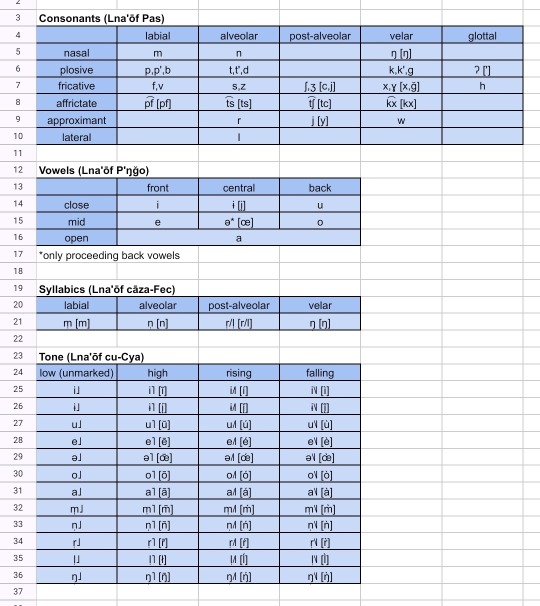
It has a syllable structure of (CC)V(CC). Plosives cannot exist word finally, clusters of consonants of the same manner are illegal, and vowel clusters are also not permitted. Syllabic consonants are grouped with vowels and behave much like them, carrying tone and stress, so they together are grouped and referred to as vocalics. Seraphic is a tonal language, employing the use of four tones: rising (á), falling (à), high (ā), and low (a). Low tones remained unmarked in both the Seraphic script and in romanization. Stress is syllable-independant. It will take either the ultimate, penultimate, or rarely the antepenultimate. Stress always falls on the syllable with a voiceless initial obstruent nearest to the end of the word. If none are available, it will fall on the syllable with an initial sonorant within the same parameters. Stress will never fall on a voiced obstruent. For clarity, I'll provide a key describing the pronunciation of the romanization.
Sounds that are similarly pronounced as they're read in American English:
m, n, p, b, t, d, k, g, f, v, s, z, y, w, l
Sounds that have special pronunciations:
ŋ, like the ng in English "sing"
p', like the ጴ in Amharic "ጴጥሮስ"
t', like the t' in Navajo "yá'át'ééh"
k', like the კ in Georgian "კაბა"
', like the the space within English "uh-oh"
c, like the sh in English "sharp"
j, like the s in English "measure"
x, like the gh in English "ugh"
ğ, like the γ in Greek "γάλα"
pf, like the pf in German "Pfirsiche"
ts, like the z in Italian "grazia"
tc, like the ch in English "chain"
kx, like the kh in Lakota "lakhóta"
r, like the rr in Spanish "perro", although occasionally like the r in Spanish "amarillo"
i, like the ee in English "meet"
į, like the ы in Russian "ты"
u, like the oo in English "boot"
e, like the é in French "beauté"
œ, like the a in English "Tina"
o, like the o in Classical Latin "sol"
a, like the a in English "bra" although this can change to be more forward or more backward.
Another letter that might trip people up is ł, which is meant to represent the high tone syllabic 'l'. Otherwise, syllabics are written the same as their pulmonic counterparts, with tone markers written when applicable.
Nouns
Nouns make up the bulk of the Seraphic lexicon. Every noun is grouped into one of seven classes:
Solar class: nouns related to seraphim or seraph-like beings, and seraph body parts. Prefix appears as zā-, zō-, zē-, s-, or ts-.
sēr = "person"
Astral class: nouns related to non-seraph animate lifeforms (their equivalent to "animals"). Prefix appears as ğr-, x, or kx-.
xuc = "cherub"
Vital class: nouns related to inanimate lifeforms (their equivalent to "plants"). Prefix appears as wā-, wō, w-, ū-, wē-, or wī-.
wējlux = "tree"
Terranean class: nouns related to landscapes, locations, and natural phenomena. Prefix appears as va-, vo-, vu-, f-, and pf-.
voxāl = "sun"
Metallic class: nouns related to inanimate objects, both natural and artificial. Prefix appears as ja-, jo-, c-, or tc-.
jağrú = "rock"
Lunar class: nouns related to abstract concepts, and terms related to time. Prefix appears as la-, lo-, le-, li-, y-, or l/ł-.
levren = "job"
Oceanic class: nouns related to general words, tangible concepts, numbers, all adjectives, and non-incorporated loanwords. Prefix appears as a/ā-, o/ō-, or aw-.
awuf = "group"
Adjectives do not agree in class, due to the fact that nouns originally are derived from adjectives, and noun classes acted as a way to differentiate between nouns and adjectives.
fa = "warm, hot"
jafa = "fire" (lit. "a hot thing")
When adjectives are used as predicatives, they decline into the oceanic class in order to take the procedurals (once more, will expand upon later).
Nouns also decline for four numbers: singular (one thing, usually unmarked), dual (two things, both things; suffixes as -ac, -oc, -œc, or -c), plural (things, many thing; suffixes as -n, -an, or -in), and collective (every thing, all things; suffixes as -āf/ōf, -áf/-óf, or -'ōf).
Seraphic doesn't use pronouns. Everything and everyone is referred to by name, including yourself. From our perspective, the Seraphic language constantly speaks in the third person. However, it can be repetitive to use the same name over and over again in a sentence, and sometimes you don't know the name of things, so they'll apply what I've called pro-forms. They consist of the demonstrative adjectives fl "this", sl "that", and xl "yon" declined into the Solar class and taking the place of the first, second, and third person respectively. For ease of reference, I'll provide the forms and their declensions below.
zāfl (I/me), zāflc (both of us), zāvlin (we/us), zāfláf (all of us)
zāsl (you), zāslc (both of you), zāzlin (you guys), zāsláf (all of you)
zōxl (they), zōxlc (both of them), zōğlin (many of them), zōxláf (all of them)
Seraphic makes no distinction in the gender of the speaker, in this regard. Although these resemble pronouns, they're not meant to be used as often as regular pronouns, and whenever possible it's much preferred that you refer to someone or something by name.
Adjectives and Prepositions
Adjectives are fairly straightforward. Adjectives follow the noun they modify (e.g. sēr tan "big person"), and agree with them in number (e.g. sēr tan "big person" vs sērn t'aŋon "big people"). Adjectives agree in the singular form with singular and collective nouns, and they agree in the plural form with dual and plural nouns.
There are three main types of adjectives: native adjectives (e.g. cna "good"), borrowed adjectives (e.g. anzn "nice"), and noun-derived adjectives (e.g. arfi/ofi "new"). Native and borrowed adjectives don't agree with noun classes, but noun-derived adjectives do. It originated from the animacy-based adjective agreement system in Proto-Seraphic, which has been lost in all other adjective instances. When you want to make a noun into an adjective you'll affix one of two prefixes to it: ar- (if agreeing with Solar, Astral, and Vital nouns) and o- (if agreeing with Terranean, Metallic, Lunar, and Oceanic nouns). There are specific rules on the forms each prefix takes based on the noun they're attached to:
"ār-" when preceeding high or falling vocalic syllables (e.g. sēr ārzājna "popular person")
"ar-" when preceeding low or rising vocalic syllables (e.g. wēn arfe "local fruit")
"ó-" when preceeding high or falling vocalic syllables (e.g. lalel ówē "grassy flavor")
"o-" when preceeding low or falling vocalic syllables (e.g. lesar olvulvren "economic problem")
"ōw-" when preceeding words that start with a vocalic (e.g. lnin ōwāsāvbas "momentary event")
Prepositions occur before the nouns they modify, and don't change form in any circumstance. There are currently 19 prepositions in the modern language, and they are usually connected to nouns via a hyphen (e.g. e-fe "at (the) place"):
cu = of; indicates possession
pr̄ = indicates the indirect object, equivalent to "to" in the phrase "The man sends the letter to me."
in/īn = as or like; indicates similarity or resemblance. Will either be low or high tone depending on the tone of the following syllable.
e/ē = at or on; indicates location.
tsa = near or for; indicates relative distance from a location or an action performed for the sake of the referent.
cni = without; indicates a lack of possession or company.
wa = in or inside of; indicates interior position.
tn = on top of, above, or before; indicates superior position or a prior instance in time.
pux = under, beneath, or after; indicates inferior position or a following instance in time.
pi = with, together with; indicates being in company of or making use of the referent.
fān = from or away from; indicates the motion of leaving the referent.
ku = out of; indicates motion from within the referent towards the exterior.
tun = into or through; indicates motion from outside the referent towards the interior.
xel = to or towards; indicates the motion of approaching the referent.
kxun = across; indicates motion from one location to another
pn̄ = around; indicates location surrounding the referrent.
cāza = between; indicates location in the middle of the referrent.
tē = after, behind; indicates posterior position.
fr = during; indicates a moment in time
Prepositions aren't combined in Collective Seraphic, but may be in certain instances in colloquial speech.
Procedurals
Okay, this is probably the most complicated part of Seraphic, so I'm going to need to get into things individually. First, I'll start with defining a procedural itself. Procedurals are the term I use for the prefixes used to describe the relationship or process of and between the agent noun and the patient noun. These are what act as the equivalent to "verbs" in earth languages. There are three in use:
Existential: used to denote a state of being or equivalence between agent and patient, or to the patient and itself. Equivalent to English "to be" (e.g. A is B, there is B). Usually prefixes as some variant of n-, m-, or ŋ-.
Actional: used to denote an action or process between the agent and patient, or with the patient and itself. Equivalent to English "to do" or "to act upon" (e.g. A acts upon B). Carries a connotation of agency and intent. Usually prefixes as some variant of re-, ra-, or r-.
Resultative: used to denote an occurence or change in state between agent and patient, or patient and itself. Equivalent to English "to become", "to happen", or "to change into" (e.g. A becomes B, B happens to A). Carries a connotation of passiveness or motion. Usually prefixes as some varient of ed- or ez-.
The procedural will change its form slightly depending on the class and declension pattern of the noun it modifies. It always affixes to the patient noun, demonstrating a relationship of an action and what is being acted upon. In this way, the patient can be clearly identified. In transitive or causative clauses, the word order is always S(P)O, with the agent acting as the subject and the patient as the object. In intransitive and passive clauses, the word order is always (P)S, with the patient acting as the subject and the agent demoted to the indirect object or omitted entirely.
Although seemingly limiting, using these three procedural, as well as prepositions, nouns, and adjectives, altogether can be used to make all sorts of verb equivalents that are called "procedural phrases". I'll demonstrate how to build a sentence now. First thing we need to know is the subject and object:
Sāx ... jafa (The child ... the fire)
Next, I'll add the actional procedural in the present tense to this.
Sāx rejafa (The child acts upon the fire)
By itself this is technically grammatically correct, but it doesn't really mean anything. It's too broad. So we add a prepositional phrase to specify exactly what action the child is taking towards the fire.
Sāx pi-sīman rejafa (The childs acts upon the fire with (their) eyes)
Now we know that the child is performing an action involving the use of their eyes. Now of course this could mean many different things in English, but in Seraphic the first thing that comes to mind would be fairly obvious: to see! Thus, "Sāx pi-sīman rejafa" would be the same as saying "The child sees the fire" in English! There are a lot of set phrases that equate to verbs, and remain consistent in their arrangement. Often differing phrases are a useful way to ascertain where someone is from or what their first language is.
Tense and Aspect
Seraphic has six main tenses: two pasts, two presents, and two futures. The two pasts consist of the recent past (happening recently) and the remote past (happening a long time ago), and they prefix and/or combine with the procedural.
Sāx pi-sīman ğrejafa (The child just saw the fire)
Sāx pi-sīman eğrejafa (The child saw the fire a while ago)
Similarly, the future tenses consist of the near future (will happen soon) and the distant future (will happen eventually).
Sāx pi-sīman drejafa (The child will soon see the fire)
Sāx pi-sīman izrejafa (The child will eventually see the fire)
The present tenses consist of a general present tense (happens) and the infinitive (to happen) which is used with auxiliaries and copulae and carries no presence in time.
Sāx pi-sīman rejafa (The child sees the fire)
Pi-sīman ezrejafa (To see a fire)
Whether someone considers an event to be nearer or farther in time from them is completely up to their discretion. There's no set timeframe for when to use the recent vs. remote past, it's all fairly subjective. However, whether you decide to use the recent or remote can really indicate whether you believe something to be in the distant past or future, or just a few moments ago or soon.
Seraphic also makes use of two copulae, the perfective -r and the imperfective -l, helping clitics that expand on the aspect of the procedural, i.e. how the procedural happens over time instead of when in time. The copulae are separate from the procedural, being placed directly before it and conjugating on their own similarly to the lexical procedural. When the copulae are in use, they are conjugated instead of the lexical procedural, while the lexical will be put into the infinitive. The exception to this is if the point in time is considered necessary to be stated for the sake of clarity or emphasis, in which case the lexical verb will also conjugate (though this isn't considered to be the default). The two copulae each conjugate to six tenses, and give 12 individual aspects in total. They are as follows, starting with the perfective:
āgxōnr - Pluperfect: indicates that the action happened at a point before some time in the past either specified or implied (e.g. āgxōnr nidsl "that has happened")
xōnr - Preterite: indicates that the action happened in the past with no reference to if it was completed recently or remotely. A general past (e.g. xōnr nidsl "that happened")
nar - Relative: indicates relative clauses, i.e. clauses that act to modify a noun similarly to an adjective. Equivalent to "that", "who", or "which" (e.g. lsl nar nidsl "the thing that happens")
ednr - Gnomic: indicates general truths, common knowledge, and aphorisms (e.g. ednr nezłsl "things happen")
t'enr - Future Simple: indicates the action will happen in the future with no regard to how near or far it is from the present (e.g. t'enr nidsl "that will happen")
āt'ēnr - Future Perfect: indicates that the action will happen before a time or event in the future (e.g. āt'ēnr nidsl "that will have happened")
And the imperfective:
ŋ̄xōzl - Discontinuous: indicates that an action was happening in the past, but is no longer happening in the present (e.g. ŋ̄xōzl nidsl "that used to happen")
xōzl - Habitual: indicates that an action is done often or out of habit (e.g. xōzl nidsl "that always happens")
īzl - Progressive: indicates that an action is happening at the very moment of conversation (e.g. īzl nidsl "that is happening")
nizl - Prospective: indicates that an action will be starting to, or is in the process of happening (e.g. nizl nidsl "that is about to happen")
t'ezl - Iterative: indicates that an action happens again, repeatedly, or more than one time based on context (e.g. t'ezl nidsl "that happens again" or "that happens again and again")
nt'ezl - Continuative: indicates that an action happens continuously and without end (e.g. nt'ezl nidsl "that still happens")
With both tense and aspects, this largely expands the capability of Seraphic in referring to time.
Moods
Seraphic makes use of seven modal particles to denote seven moods. They are always placed at the beginning of clauses, and no two modal particles can exist in the same clause. They are grouped into four categories: the declaritive (indicative and negative), the inferential (evidential and interrogative), the deontic (volitive and imperative), and the epistemic (subjunctive and conditional). They add extra clarity in the speakers mood or opinion concerning the clause they modify, and are as follows:
Indicative: base form of a clause. Indicates that the speaker is stating a fact or what exists, and is unmarked (e.g. idsl "that happens")
tu - Negative: indicates that the speaker is stating a fact that is untrue or what doesn't exist. Usually only appears in formal, official texts, as the first syllable of the procedural will chage tone to contrast as well and leaves the particle unneccesary in colloquial speech (e.g. tu īdsl "that doesn't happen")
cuc - Evidential: indicates that the speaker is stating a fact that they believe or understand to be true, regardless of having experienced it or not. (e.g. cuc idsl "apparently that happens") Direct evidentiality is denoted using a different method.
an/ān - Interrogative: indicates that the speaker is confirming whether a statement is or isn't true. Forms questions (e.g. an idsl? "does that happen?")
tcān - Volitive: indicates that the speaker desires for the statement to be true (e.g. tcān idsl "that wants to happen" or "that needs to happen" or "that should happen")
má - Imperative: indicates that the speaker is giving a command or suggestion, to themselves and/or to other referents. Functions additionally as a cohortative and a jussive (e.g. má idsl! "let that happen!")
tir - Subjunctive: indicates that the speaker believes the statement to be possible or likely (e.g. tir idsl "that could/would/might happen")
nun - Conditional: indicates that speaker believes the statement to be possible under specific circumstances or conditions (nun idsl "if/when that happens..."
Miscellaneous
That's about the basics of the Seraphic language outline. I'd like to eventually get into things like comparison, evidentiality, declension forms and the like, but those are all topics that definitely need their own individual posts. Real quick, I want to provide one more additional fact about Seraphic.
Seraphic uses base-16, meaning it groups numbers in sets of 16 instead of sets of 10 like we do. 1-16 would be written 1, 2, 3, 4, 5, 6, 7, 8, 9, A, B, C, D, E, F, 10. 10 would be read as 16, and equally 20 would be 32. They're still counting the same amount of things, they're just dividing it up differently!
Anyways that's about it, I hope to share more about Seraphic soon, and when the comic gets released I hope you'll all be able to read it and pick out the many many lines of Seraphic I've poured into it!
ŋKowīci cu-stux 'ōf tsa-levp'ā cu-zāsláf pi-lizt'n ğōdjasa! (Thank you all so much for reading!)
#conlang#constructed language#artlang#grammar#phonology#syntax#linguistics#seraphic#collective seraphic#info post#hope i didn't make a fool of myself in front of the whole community#accidentally showed the world i dont know shit abt linguistics gotdamn#im sure itll be fine#writing system tutorial forthcoming
19 notes
·
View notes
Text
Pocket Sand - Pilot Episode: Inkwel and Shikari
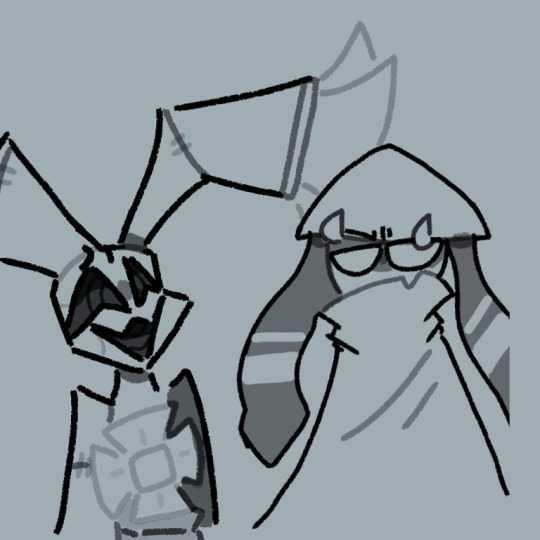
Inkwel: Hehehe! W ll hiya the e, Mi s Shikari!
Shikari: Oh, it's yXu. Get Xut of hXre, I DXN'T want tX talk.
Inkwel: I don't me n to be rud b t I don't re lly... want t ...
Funny Stor , most of th peopl here ar n't the fr endliest... and if they ar , they pr bably want to k ll you... Hehehe....
Shikari: YeXh, and I WXll, tXo. Keep mX out of thXs you SXft littlX freak.
How'd yXu even gXt herX? You get thrXwn in here Xs a thrXwaway ItXm or sXmething?
Inkwel: Hehehe... No, I'm just l ke you. A Shadow Crystal h lder...
Shikari: ThXt's hard to belXeve.
Inkwel: It s but it's true. I als had on of those Crystals.
Shikari: Yeah but thXse don't savX you frXm lXXking likX you'd be beXten to a pXlp in less than a sXcond.
Inkwel: Hehehe, y u don't think 'm tough, don't you m ss? I'm plenty t ugh!
Shikari: I wasn't talkXng abXut that, you're a FXXKING plXshie.
Inkwel: Hey! Th t wasn't n ce...
Hmmmm... h s anyone h re told yo abo t my EYES?
Shikari: NXpe.
Inkwel: Hehehe! W ll in th t case!
*Inkwel puts his puppet in one of the holes where his eye should have been. Shikari looks on in mild amusement.*
Shikari: So? YXu don't hXve eyXs? I knXw likX five Xther DarknXrs thXt havX the same thXng-
Inkwel: Oh I wasn't b rn lik this! Mr Ro k stole them!
Shikari: . . .WhXt?
Inkwel: Ye h! He r pped them all o t and left me to d e in m set! Hehehe!
Shikari: . . .
Inkwel: And if y u don't mind m add ng to that, but wh n I did g t them b ck, I turn d int a fre ky monst r!
Shikari: . . .Huh. . .ThXt's . . .MetXl as fXXk.
Inkwel: Th t's not h w I would w rd it, b t sure!
Shikari: So lXke, are yXu tryXng to gXt rXvenge on thXt Rook GXy?
Inkwel: Oh no n no! I w uld never! R venge is wr ng and it'd be cru l of me t do that!
Shikari: . . .He lXft you to dXe. . .
Inkwel: Ye h. . .But p ople can ch nge and ma be he'll r alize that he mad a mist ke some t me in the fut ure! Hehehe!
Shikari: . . .MXn. And I thXught yXu were kind Xf cXXl for a sXcond. You'rX just anXther WXMP likX the rXst of thXm.
Inkwel: I g t that a lot. . .hehehe. . .I he rd that fr m my wife n our f rst date. . .
Shikari: Hm?
Inkwel: Oh yeah! My w fe! Sh 's the best. . .b t I can't t lk to her when I'm h re...
Shikari: WhXt? Did shX dXe or somethXng?
Inkwel: h HEAVENS no! She's j st kind f. . .liv ng in a re lm betwe n realit is all!
W it. . .maybe I c n talk to her h re! Th s ain't a qu ote- n-q ote can n story s I think she c n come ov r!
Shikari: FXXking go for it.
Inkwel: Alr ghty!
*A few minutes pass*
Inkwel: h Shikari!
Shikari: WhXt do yXu want- HXLY SHXT.
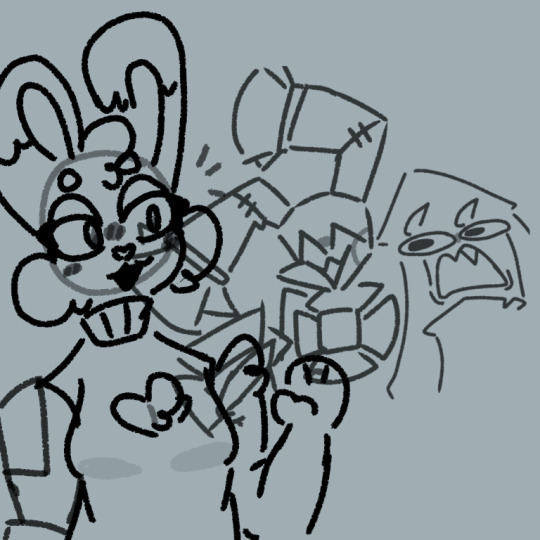
Nora: You must be that Shikari girl he was talking about. I'm Nora.
Inkwel: I pulled some strings nd w s able to g t h r here!
Shikari: BRX.
YXU DIDN'T TXLL ME SHX WXS A BXDDIE.
Inkwel: what the fuck did you just call my wife?
- End of Pilot -
Bonus Fanart for making it to the end!
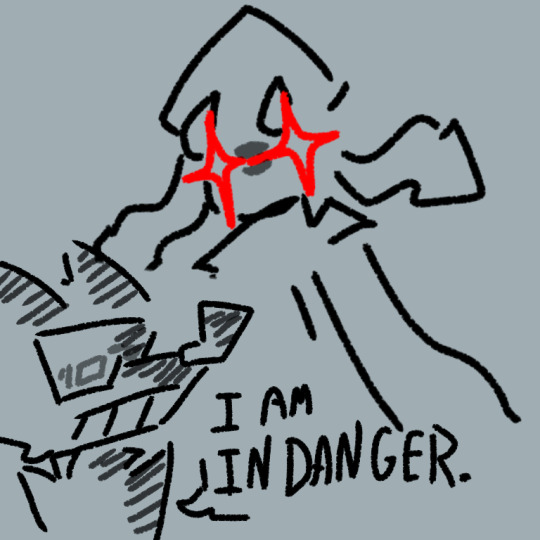
Shikari by: @mercair
Inkwel, Nora, and Rustflare by: Me!
#deltarune secret boss#deltarune oc#deltarune#deltarune fan character#secret boss#ask box#deltarune fanart#shikari#inkwel#Nora#Yes Inkwel does have a noncanon wife#I love these two they are so cute together#Rustflare#I FXXKING HXTE THXT GXY!!!#Pocket Sand#Deltarune Pocket thing
12 notes
·
View notes
Text
mini analysis: censored voicelines
010: "**... **’s g***."
"Ah... It's gone."
not too sure. didnt really have much to work with here.
009: "* c**'t ** a**t*in* ***e *o* **em."
"I can't do anything else for them."
took me a long time to get those middle ones but when i noticed the "t*in*" i figured it was "thing".
008: "*’* s****."
"I'm sorry."
easiest one so far ngl. voting forgiven just for that.
007: "**– N*, **, t**s ***n’t s**p*s*d t* h***en–"
"[???]– No, no(?), this wasn't supposed to happen–"
that first one could be another no or an "ah" idk but it doesnt really matter either way.
006: "* n*** t* *** h** b**k, **** it!"
"I need to [???](win?) [???](him/her?) back, damn it!"
yeah this one is mostly speculation. i could be totally off with the him/her thing.
005: "Y**, i*’* b*** d**e. ***d ** *ve* n*w."
"[???](yes?), it's been done. [???] is over now."
deadass this one had me googling words with 4 letters starting with b. couldnt figure out the most important word??? cries.
004: "H**. H** un***e**ed."
"[???](huh? hah?). How [???](unaffected?)."
:( its hard
003: "Y*u sh**ld h***e kn*** t*** ***n’t g**d f*r th*m. **u s****d h*v* ***w* **i* ***n’t *oo* **r t**m. Th**’*e d**d b**au*e o* y*u."
"You should have known this wasn't good for them. You should have known this wasn't good for them. They're dead because of you."
oh my god. thank you. this was easy. thank you for being simple.
002: "S***!! F***! Th*s wa**’t s*****ed ** h***en! W* sh**ld h***e l**t w**n ** *a* th**– D*** i*!"
"Shit!! Fuck! This wasn't supposed to happen! We should [???] [???](left? lost?) when we had [???](that? this? them?)– Damn it!"
bro thinks hes fuuta lmaoo but yeah im a bit stumped.
001: "Y*u c**’* ** s****us… The* c*n’t **..."
"You can't be serious... They can't be..."
why so serious? -the lawyer
#submission#MUGRAM -- Theories#// crazy because i can't say anything.#// also yes I'm posting theories here o//!!
10 notes
·
View notes
Text
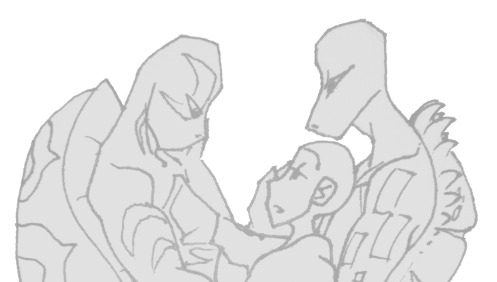
I have decided to share this crop of a wip pinup of anon x blurple ship bc i confess this one got me w e a k
Not sure I care much for shipping in general in tmnt but i can't deny some weakness for this one
disclaimers; v-shaped non-tcest polyship and the full image isn't explicit unless you count terrible leg anatomy i just don't know if it's something y'all wanna see from me -sh r u g- full version might end up on my discord but that requires me opening the actual app and that just sounds like w o r k --- s i g h
#original arts#sketch#almightyarts#almarts#rottmnt#original art#blurple#anon insert#rise leo#rise donnie#turtleposting
18 notes
·
View notes